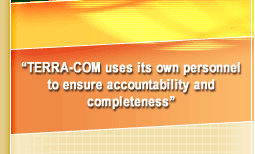Problem
A former truck stop in Madison, Florida was known to have nearly 3,000 tons of contaminated soil estimated to exist from 10 to 37 feet below land surface (Picture 1). The presence of the contaminated soil prevented the site from being developed. Because of the dense, clay makeup of the soil, excavation was determined to be the most sure method of removing the contamination. However, the area of contaminated soil was located immediately adjacent to State Road 53, which hindered the excavation of the soil from being accomplished through traditional sloping and earthwork techniques. The location of State Road 53 and the depth of the necessary excavation made traditional single-wall sheet piling cost- prohibitive due to the required depth and necessary tiebacks of such a design.
Solution
TERRA-COM's professional engineering and geology team designed an approach in which multiple, four-sided sheet piling structures were utilized to provide the necessary support to allow excavation to 37 feet below land surface. This design alleviated the need to drive the sheet pile below the excavation depth and the need to tieback the sheet pile underneath the adjoining highway.
The first box measured 50 feet in length, 25 feet in width, and 35 to 37 feet in depth (Picture 2). This box was excavated and then backfilled and compacted to a depth of 8 feet below land surface (Picture 3). The sheet piling for this structure was then dismantled and reassembled into a second box also measuring 50 feet in length, 25 feet in width, and 35 to 37 feet in depth (Picture 4). The north wall of the first box was left in place because it was common to both boxes. This box was excavated and then backfilled and compacted to a depth of 13 feet below land surface (Picture 5).
Excavation was then moved to the area west of the second box with the expectation that the structure would be stable and allow for excavation on one side after the box was backfilled. However, excavation was temporarily discontinued in this area due to instability in the box's western shoring wall. Field changes were quickly made and it was determined that the area west of the shoring box would be excavated after the removal of the northern, southern, and western walls of both the northern and southern shoring-boxes. The eastern (roadside) wall from both boxes remained in place until all excavation and backfilling was complete. This allowed the eastern sidewall of the area west of both boxes to be sloped, rather than be bordered by sheet piling, and allowed access to the soil located beneath the western shoring walls (Picture 6).
This approach allowed approximately 2,900 tons of contaminated soil to be removed from the site at a cost reduction of nearly 20% as compared to the cost of a traditional approach. Confirmatory soil sampling indicated that nearly all the contaminated soil had been removed from the site and the site was cleared for development as a result of this effort.


